Types
of Refrigerants
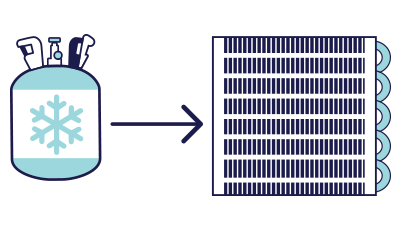
Alternative refrigerants and your air conditioner
At their most basic level, refrigerants (also sometimes called coolants) are the chemicals your A/C needs to produce cold air.
Simply put, you wouldn’t have air conditioning without the refrigerant inside your A/C’s coils.
The history of refrigerants
A/Cs have used different types of refrigerants to cool homes throughout modern history. The preferred compounds change as we discover newer and more efficient ways to complete the refrigeration cycle, as new chemicals are developed and as our understanding around the environmental impacts of these coolants expands.
In fact, we’re in the midst of a change again: the elimination of R-22 in favor of more environmentally friendly and affordable alternatives.

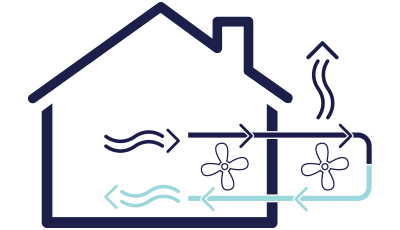
The refrigeration cycle
How refrigerants work
When used with a component like your A/C’s compressor, refrigerants absorb heat from the environment, like the warm air inside your home. This process is called the refrigeration cycle.
As the refrigerant absorbs heat from your home’s indoor air, it changes from a low-pressure gas into a high-pressure liquid. Then, your A/C's components send the refrigerant outside. A fan blows hot air over the A/C's copper or aluminum coils before exhausting that same hot air outside your home (you obviously don’t want that hot air in your house).
As the refrigerant cools down, it transitions back to a low-pressure gas. Finally, a fan inside your home blows air over the cooled coils to distribute the now-cooled air throughout your home. The cycle repeats until your home reaches the temperature you’ve set on your thermostat.
Classes of refrigerants
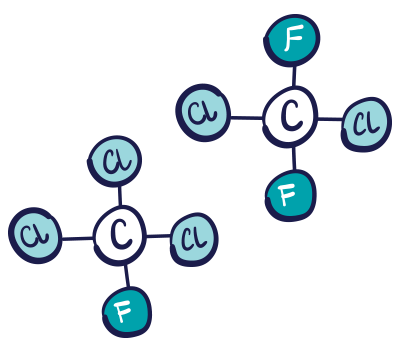
CFCs
Chlorofluorocarbons (CFCs)
You may have heard about CFCs. They’ve been used in aerosol sprays, as blowing agents for foams and packing materials, as solvents and also as refrigerants.
In the late 1800s and early 1900s, toxic gases like ammonia, methyl chloride and sulfur dioxide were used as refrigerants. After several fatal accidents involving methyl chloride in refrigerators in the 1920s, Frigidaire, General Motors and DuPont set out to find a safer alternative.
This search led to CFCs, which were first created in the late 1920s. Frigidaire patented the first formula, but by 1930, General Motors and DuPont were producing Freon® (DuPont’s registered name for the CFCs they produced), a name you’re likely familiar with.
By the 1930s, Freon-11 (or CFC-11) was being used in the world’s first self-contained home A/C. Freon’s reputation as a safe and non-toxic coolant led to its widespread use in homes throughout the 1950s and 1960s.
CFCs are safe to use most of the time, but the 1970s led to another discovery: CFCs react differently in the Earth’s stratosphere, or upper atmosphere. That’s because CFCs contain chlorine, which is highly reactive with ozone. Ozone is a form of oxygen, but not the type that we breathe. When chlorine molecules meet with ozone molecules, ozone molecules turn into run-of-the-mill oxygen molecules. In other words, this damages the ozone layer.
We’ll spare you the rest of the science, but the gist of this new information was that CFCs resulted in a loss of stratospheric ozone and an increase in the greenhouse gas effect.
We need ozone. It’s a trace gas that absorbs harmful ultraviolet radiation and protects plants and animals from biological damage. That’s why 43 countries signed a global environmental treaty, the Montreal Protocol to Reduce Substances that Deplete the Ozone Layer, in 1987.
As a result, production of CFCs was reduced dramatically, with all production stopping by 1994. This led to the use of our next type of coolants: hydrochlorofluorocarbons (HCFCs).
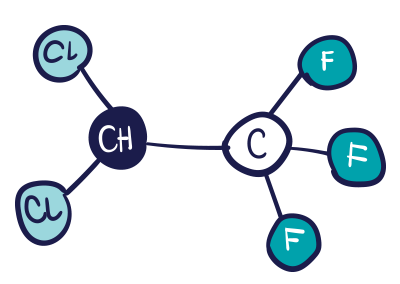
HCFCs
Hydrochlorofluorocarbons (HCFCs)
As countries phased out CFCs, A/Cs needed an alternative refrigerant. By the early 1980s, companies like DuPont were creating alternate compounds with fewer environmental dangers, including HCFCs.
Freon-22, or R-22, was one of these compounds. Studies showed that it was slightly less damaging to the ozone layer than R-12. Because HCFCs have a hydrogen atom, the harmful chemicals decompose before they reach the Earth’s upper atmosphere. Since they don’t have any chlorine atoms, they don’t attack the ozone layer. Further, they only “survive” for 2 to 40 years. CFCs tend to stick around for approximately 150 years, so the difference is clear.
Still, HCFCs do contribute to the greenhouse gas effect. Because they’re still damaging to the Earth’s ozone, the EPA mandated their phase out with the Clean Air Act of 2010. R-22 became illegal to manufacture or import into the United States on January 1, 2020.
That leaves us with the newest class of refrigerants: hydrofluorocarbons (HFCs).
Hydrofluorocarbons (HFCs)
HFCs are the newest alternative refrigerants. They contain no chlorine (and are thus safer for the environment), provide improved air quality, increase the reliability of your A/C and, as far as the homeowner is concerned, are just as efficient at cooling homes as R-22.
If your A/C uses R-22 and develops a leak or needs another repair, your HVAC technician will likely recommend that you retrofit your existing A/C unit to accept an alternative refrigerant, like Puron® (also known as R-410A).
What does all of this mean for you and your home? Since the government mandated a 90% reduction in R-22 production by 2015, and a 99.5% reduction by 2020, it’s going to become much more expensive to top off your A/C’s refrigerant with R-22.
A/Cs don’t last forever, and your old unit will need service and repairs at some point. Keep reading to learn about the benefits of alternative refrigerants and your different options. When that inevitable repair becomes necessary, you’ll already have all of the knowledge you need to make the most informed decisions.
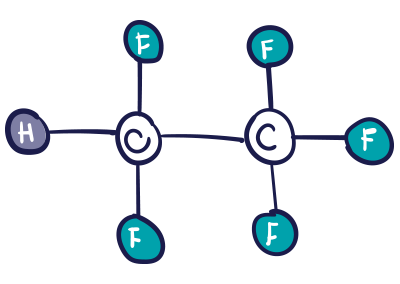
HFCs
What is R-22 refrigerant?
Now that you understand the basics of refrigerant and why it’s such an important part of your home’s air conditioning system, let’s talk about the refrigerant you’re most likely to find in your A/C if it was manufactured before 2013: R-22. If you aren’t sure when your unit was manufactured, learn how to find that information here.
R-22 is also known as Freon-22 or HCFC-22. The full chemical name of this colorless gas is chlorodifluoromethane or difluoromonochloromethane, but you don’t need to remember those terms to understand R-22 and how it works.
R-22 has a low boiling point, which makes it a very effective refrigerant. Since it’s non-toxic and non-flammable, it’s also very safe to use in both residential and industrial settings. However, the chlorine molecules in R-22 deplete the Earth’s ozone layer. So, this gas isn’t safe for the environment.
Since January 1, 2020, R-22 is illegal to manufacture or import in the United States. Though it's no longer legal to produce R-22, using available R-22 is still legal. Many A/Cs still rely on R-22 to operate effectively. If your A/C uses R-22, you won’t have to replace it and can continue to operate it. However, the way you'll repair it will be different.
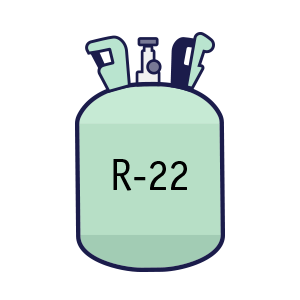
Even as the US and other developed countries phase out R-22 production, its worldwide use continues to rise. Citizens in rapidly growing countries, like India and China, are purchasing more A/C units than ever before, and this high demand, combined with R-22’s reputation as safe for people, make this refrigerant an attractive choice for consumers around the world.
Even as global use of R-22 rises, it’s still important for developed countries like the US to lead the way in adopting newer, more environmentally friendly refrigerants. Once researchers realized the negative impacts of refrigerants like R-22, it was clear that alternative refrigerants needed to be used.
Today’s alternative refrigerants don’t eat away at the Earth’s ozone in the same way R-22 does, but it took us some time to adapt these more planet-friendly refrigerants. Humans have used different compounds as refrigerants throughout our modern history, and it all began in the late 1800s and early 1900s.
Understanding the different types of alternative refrigerants
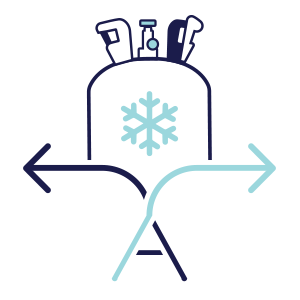
The good news is that there are several alternatives to R-22 refrigerant that are readily available, less expensive and better for the environment. If your older A/C unit needs servicing, you have several options, including retrofitting your A/C to accept an alternative refrigerant or replacing it with a newer A/C that uses an alternative refrigerant.
Note that your HVAC service technician may suggest a different refrigerant based on the specifics of your A/C and which refrigerants they can most easily purchase. There are a wide number of alternative refrigerants available, and different HVAC supply stores carry different types of refrigerant.
The experts will help you choose one that works best for your needs and for your existing A/C. Whichever alternative they use, even if it’s not listed here, can restore your A/C’s functionality.
What is Puron/R-410A?
Like Freon, Puron is also known by another name: R-410A. Nearly all new systems manufactured use R-410A. It is not compatible with older R-22 systems.
R-410A was introduced in the 1990s as an alternative to ozone-damaging HCFCs. If you see an HVAC service technician with a pink-colored cylinder, they’re using R-410A.
R-410A contains no chlorine, and therefore does not contribute to ozone depletion. It’s also compatible with A/Cs that have higher SEER ratings (as compared to a system using R-22). Therefore, its use also reduces power consumption in A/C units.
Homeowners should note that R-410A does require the use of specific parts and components in their A/C, because it operates at higher pressures than other refrigerants.
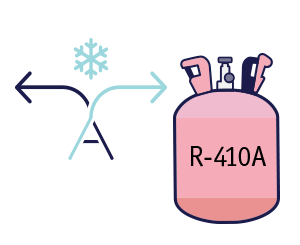
Benefits of R-410A
What is MO99?
MO99, or Freon MO99, is an effective replacement for R-22. It matches R-22 in terms of efficiency and the amount of refrigerant needed in most A/Cs. It's also compatible with the most commonly used types of oil (oil is used in your A/C's compressor unit).
Homeowners with A/Cs manufactured before 2013 should note that retrofitting their system to accept MO99 does require some labor.
LEARN MORE about retrofitting an older A/C system.
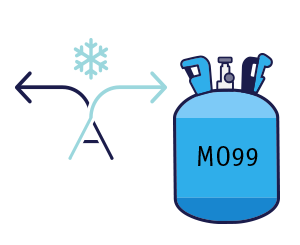
Benefits of MO99
What is R-421A?
Some alternative refrigerants are blended, which means they contain two or more types of refrigerant. R-421A is one such blend, and it combines R-125 and R-134A.
Homeowners with A/Cs manufactured before 2013 should note that retrofitting their system to accept R-421A does require some labor.
LEARN MORE about retrofitting an older A/C system.
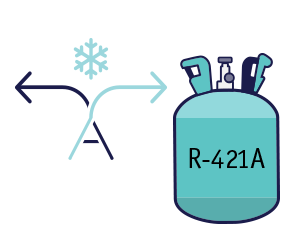
Benefits of R-421A
What is R-427A?
R-427A (also known as Forane® 427A) is another environmentally safe alternative to R-22. Depending on where your HVAC service technician gets their supplies, this could be the refrigerant that the supply house carries.
Homeowners with A/Cs manufactured before 2013 should note that retrofitting their system to accept R-427A does require some labor.
LEARN MORE about retrofitting an older A/C system.
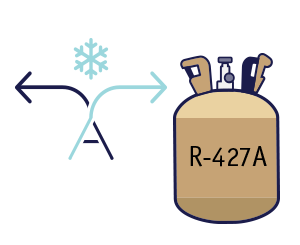
Benefits of R-427A
Frequently asked questions about air conditioners and refrigerants
What is a Refrigerant?
Refrigerants, also called coolants, are the chemical compounds that work with your air conditioning system to provide your home with cool air. R-22 is the most common type of refrigerant found in air conditioners that were manufactured before 2010.
There are different types of refrigerants, and the use of these compounds is regulated by the Environmental Protection Agency. That’s because their usage has an impact on the environment, and our understanding of that impact continues to develop and evolve over time.
WHAT IS R-22?
R-22 is a hydrochlorofluorocarbons (HCFC) and a type of refrigerant gas that has been used in air conditioning systems for many years.
The EPA’s Clean Air Act of 2010 mandated the phase-out of R-22 production, because researchers discovered that it depleted the ozone. The government mandated a 90% reduction in R-22 production by 2015, and a 99.5% reduction by 2020.
HOW CAN I TELL WHEN MY AIR CONDITIONER WAS MANUFACTURED?
Manufacturers always include the date of manufacture in the air conditioning unit’s serial number, though they can be displayed differently.
The manufacture date, sometimes written as MFG date, usually appears on the nameplate of your A/C unit, near your serial and model number.
If you can’t find the manufacture date, but you do see the serial number and model number, simply enter the serial number, model number, and the brand name of your A/C into any search engine. It should bring the manufacture date up for you.
WHAT ARE ALTERNATIVE REFRIGERANTS?
Since HCFCs like R-22 were found to be environmentally damaging, it was determined that there needed to be another option. Alternative refrigerants are classified as hydrofluorocarbons (HFCs) and they don’t contain any ozone-depleting chlorine. Aside from being better for the environment, they’re more affordable than R-22, work efficiently and increase the serviceability of your A/C unit.
If your air conditioner uses R-22 and develops a leak or needs another repair, your HVAC technician may recommend that your existing A/C unit be retrofitted to accept an alternative refrigerant.
To learn more about the benefits of alternative refrigerants, click here.
CAN’T I JUST USE AN ALTERNATIVE REFRIGERANT IN MY OLDER AIR CONDITIONING SYSTEM?
If your air conditioner uses R-22 refrigerant, you can’t just top off with an alternative refrigerant. Your system would need to be retrofitted in order to allow the use of alternative refrigerants.
WHAT DOES IT MEAN TO “TOP OFF,” “RECHARGE” OR PERFORM A “GAS AND GO” ON AN AIR CONDITIONING SYSTEM?
When talking about adding more refrigerant to an air conditioning unit, technicians refer to the process as “topping off” or “recharging”.
Essentially, the chemical refrigerant inside of the unit is being refilled. When you hear the term “charging” it’s also a reference to adding refrigerant into the air conditioning system.
CAN I TOP OFF MY AIR CONDITIONER BY MYSELF?
No, you cannot top off your air conditioner’s refrigerant on your own. Federal law regulates the use and installation of refrigerants and special licensure and/or certifications are required for the professionals who work with these chemicals.
HOW CAN I TELL WHEN MY AIR CONDITIONER NEEDS MORE REFRIGERANT?
When your air conditioner needs to be topped off or recharged with more refrigerant, one of the first signs is warm or room temperature air.
However, there could be any number of reasons for a malfunctioning air conditioner. If you have a Home Warranty Service Agreement from 2-10 HBW, you can place a request for service and 2-10 HBW will dispatch a service contractor to your home. If you do not have a Home Warranty Service Agreement, you should call an HVAC technician to assess your system’s functionality.
WHAT SHOULD I DO IF MY AIR CONDITIONER BREAKS DOWN?
If you think you might have a problem with your air conditioner and you have a Home Warranty Service Agreement from 2-10 HBW, you can place a service request and 2-10 HBW will dispatch a service contractor to your home. If you do not have a Home Warranty Service Agreement, you can call an HVAC technician to assess your system’s functionality.
IS IT ILLEGAL TO BUY AN AIR CONDITIONER THAT USES R-22?
This is a problem you’re unlikely to encounter, since the manufacture and installation of new equipment using R-22 is now illegal.
Remember that you can still continue to service and maintain your existing air conditioner, even if it uses R-22. You just can’t install a new air conditioner that uses R-22.
HOW MUCH DOES IT COST TO USE AN ALTERNATIVE REFRIGERANT?
The costs of retrofitting an existing air conditioner to use alternative refrigerants will vary depending on the type of retrofitting that’s needed.
WHY CAN’T I JUST HAVE LEAKS IN MY A/C REPAIRED?
Yes. There are products in the market that can do an immediate and effective job of repairing and sealing refrigerant leaks even if the technician cannot find the leak’s location.
WHY WOULD MY AIR CONDITIONER NEED ALTERNATIVE REFRIGERANT?
Air conditioners can develop leaks over the course of normal use, which is one of the primary reasons your refrigerant would need to be topped off.
If your air conditioner was manufactured before 2013, it likely uses R-22 refrigerant. Due to EPA regulations this gas is good as gold — it’s expensive and hard to find.
WHAT IF MY R-22 IS ONLY SLIGHTLY LOW? WILL TOPPING OFF BE CHEAPER OR EASIER?
Topping off an A/C system with a known leak is illegal, but once the leak has been diagnosed and addressed by an HVAC technician, it can be a viable practice. Topping off with R-22 may be more economical in the short term. But, in the long run, R-22 is becoming more difficult to find, and that’s if you can find a technician who will even work with R-22 (many will simply refer you to someone else). Further, the technician can guesstimate how many pounds you’ll need, but you won’t know the final count until the refrigerant is being replaced.
WHAT DOES THE RETROFITTING PROCESS LOOK LIKE?
The retrofitting process will look different based on the type of alternative refrigerant being used. Some retrofits are easy and straightforward, with minimal or no equipment replacements needed.
Other retrofits are more complex and require additional components. For more information on how an air conditioner gets retrofitted, review How An Air Older Air Conditioner Gets Retrofitted For Alternative Refrigerants.
DO ALTERNATIVE REFRIGERANTS DEPLETE THE OZONE LAYER?
No, alternative refrigerants do not deplete the ozone layer, which is why the EPA is phasing out R-22 and mandating the use of these new compounds.
SHOULD I REPLACE MY OLD AIR CONDITIONER IF IT ISN’T BROKEN YET?
If having a new, modern, and more efficient system is important to you, you might consider replacing your air conditioner.






